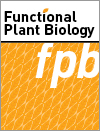Klaus Winter (Smithsonian Tropical Research Institute)

Functional Plant Biology
Volume 48 Number 7 2021
Special IssueDiversity of CAM Plant Photosynthesis (Crassulacean Acid Metabolism)
Klaus Winter (Smithsonian Tropical Research Institute)
FPv48n7_FODiversity of CAM plant photosynthesis (crassulacean acid metabolism): a tribute to Barry Osmond
The foreword to the special issue on diversity of CAM plant photosynthesis (crassulacean acid metabolism) highlights some of the key contributions of the Australian plant biologist Professor Charles Barry Osmond to our understanding of the CAM pathway of photosynthesis and provides a brief introduction to the research papers of this issue.
Low-level constitutive CAM and drought-induced facultative CAM co-occur in leaves of the widely cultivated, aromatic tropical herb Coleus amboinicus (Lamiaceae), highlighting a notable facet of CAM-plant photosynthetic diversity.
FP20127 Abstract | FP20127 Full Text | FP20127PDF (1.7 MB) Open Access Article
Trianthema portulacastrum, a well-known C4 plant, exhibits CAM-type day-night acid fluctuations in stems, and to a lesser extent in leaves. Although nocturnal acidification is small, Trianthema is only the second genus of vascular land plants in which C4 and CAM have been demonstrated to co-occur in the same plant.
FP20247 Abstract | FP20247 Full Text | FP20247PDF (3.1 MB) | FP20247Corrigendum (3.1 MB) Open Access Article
FP20202Developing Portulaca oleracea as a model system for functional genomics analysis of C4/CAM photosynthesis

Portulaca oleracea has emerged as a model system to answer the intriguing question of how two carbon concentration mechanisms (C4 and CAM) can co-exist within a single leaf. Recent progress has been made with the study of C4 and CAM functional genomics, but similar molecular approaches have not been possible in C4-CAM facultative species. Essential tools for functional gene analysis are now available for P. oleracea, which may accelerate C4-CAM photosynthesis research and the future application of these valuable photosynthetic adaptations within crop biotechnology.
FP20151Low-level CAM photosynthesis in a succulent-leaved member of the Urticaceae, Pilea peperomioides
Measurements of CO2 gas exchange and titratable acidity revealed features of low-level CAM photosynthesis in Pilea peperomioides. This is the first report of CAM in the family Urticaceae.
FP20151 Abstract | FP20151 Full Text | FP20151PDF (1.1 MB) Open Access Article
In two Cistanthe species from the Atacama desert, CO2 uptake and leaf acidification patterns were observed that are typical of water-use efficient crassulacean acid metabolism (CAM) photosynthesis. CAM expression in the perennial C. sp. aff. crassifolia was facultative whereas CAM in the annual C. sp. aff. longiscapa was constitutive. Cistanthe becomes the sixth genus known to exhibit CAM within the family Montiaceae.
By identifying physiological traits more common in drier environments, it is possible to understand the ways in which tropical trees have adapted to deal with drought. By analysing a genus from Central and South America, we were able to test if it is more beneficial to prevent or tolerate water loss. Our results show that preventing water loss has a greater benefit to living in drier niches, which has implications for the ways in which future climates will affect tropical flora.
FP20332Metabolic profiling of epidermal and mesophyll tissues under water-deficit stress in Opuntia ficus-indica reveals stress-adaptive metabolic responses

To better understand CAM-related metabolites and water-deficit stress responses of Opuntia ficus-indica, comparative metabolic profiling was performed on mesophyll and epidermal tissues collected from well-watered and water-deficit stressed cladodes. A total of 382 metabolites, including 210 (55%) named and 172 (45%) unnamed compounds, were characterised across both tissues. This study revealed a total of 34 unnamed metabolites that accumulated in response to water-deficit stress indicating that such compounds might play important roles in water-deficit tolerance.
FP21087Leaf water δ18O reflects water vapour exchange and uptake by C3 and CAM epiphytic bromeliads in Panama
 , Miquel Arnedo and Howard Griffiths
, Miquel Arnedo and Howard Griffiths 
The paper defines the niche segregation of C3 and CAM photosynthetic pathways for epiphytic bromeliads along an altitudinal gradient in Panama. Measurement of the leaf water oxygen (18O) stable isotope composition supports transpiration by day or night, since under high humidity water vapour influx resets the leaf water 18O signal.
FP21087 Abstract | FP21087 Full Text | FP21087PDF (1 MB) | FP21087Supplementary Material (205 KB) Open Access Article



